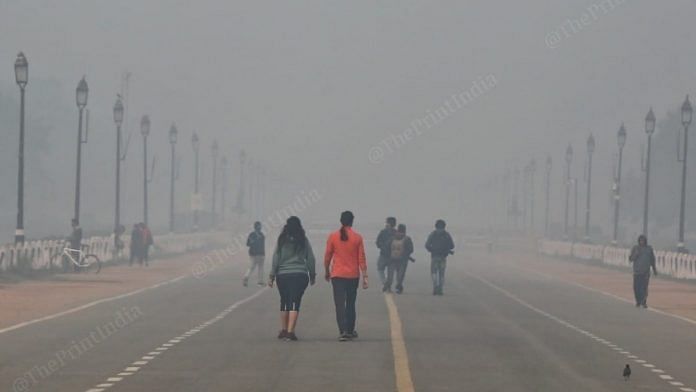New Delhi: Despite the ban imposed on the sale and use of firecrackers, Delhi saw widespread use of crackers on Diwali, leading the hourly average concentrations of PM2.5 levels to touch over 1,000 micrograms per cubic metres around midnight.
Even so, the post-Diwali pollution levels were marginally lower than what was recorded last year, with AQI at 459 at 11 am Sunday. In 2019, AQI on the day after Diwali in Delhi had touched 506. The SC ban on firecrackers last year too had failed to curb their use.
SAFAR, the pollution forecasting system run by Indian Institute of Tropical Meteorology (IITM) Pune, had predicted Saturday that Delhi would see much better AQI as compared to the past four years around the Diwali period that if firecracker ban was successful.
In 2018, the overall AQI the day after Diwali was recorded at 642. In 2017, this figure was at 367 while 2016 saw the index recording 425.
This year, Diwali coincided with a spike in stubble burning incidents in Punjab and Haryana, along with winds that transported smoke from the neighbouring states to the national capital.
As many as 2,586 incidents of stubble burning were observed over Punjab and Haryana on 13 November, leading to nearly 32 per cent of stubble share in Delhi’s AQI on Diwali night. Combined with bursting of crackers despite the ban, this pushed the city’s air quality to ‘severe’ category.
Also read: Delhi records 7,340 Covid cases Saturday, death toll rises to 7,519
Quick recovery possible
According to SAFAR’s analysis, however, there are three “very positive developments to follow now and a quick recovery from the current scenario is expected”.
The first factor is that winds that usually bring plumes of smoke from the farms of Punjab and Haryana have changed direction. Stubble fire counts also significantly reduced to around 350 Saturday. As a result, the stubble burning share in PM2.5 in Delhi’s air is almost negligible and estimated to be around 4 per cent Sunday.
SAFAR has also predicted that weather conditions Sunday will allow the pollutants accumulated over Delhi to disperse faster.
Finally, bouts of scattered rainfall are also expected this evening which will help the AQI improve. By Monday, AQI may touch the poor category if Delhi gets enough rainfall.
Also read: ‘Lockdown fatigue’ behind Delhi’s third Covid wave, experts call for behavioural change






